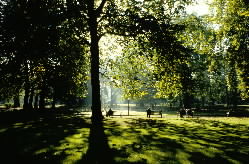
The integration of high quality green infrastructure into the urban environment can provide a number of key benefits. These include:
These benefits can be achieved most successfully when planning and management take place to ensure green space is supplied in the right place at the right time.
A summary report that covers the benefits of green infrastructure has been written by Forest Research (2010), alongside a main report to Defra providing technical information:
Benefits of green infrastructure – summary report (PDF-2362K)
Benefits of green infrastructure – main report (PDF-1211K)
Greenspace is multifunctional – it provides social, economic and environmental benefits. It supports many of the components of ‘ecosystem services’ as defined by the Millennium Ecosystem Assessment. Ecosystem services include:
These are intrinsic to biodiversity, and provide for people’s well-being – security, basic materials for good life, health, and good social relations. As most of our communities exist within the urban environment, the provision of greenspace is essential for the well-being of society.